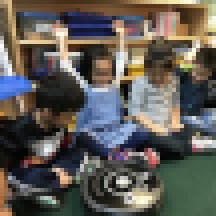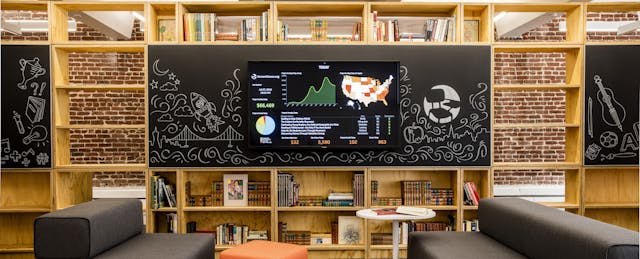Andy Yung has been teaching Pre-K in New York City for the past six years, and he works thoughtfully to incorporate technology into his instruction in a developmentally appropriate way. “When you think of tech in the classroom, everyone thinks of iPads and SMART boards,” he says. “But with younger ages, they’re often too exposed to screens, so I had to figure out how tech would look different in a Pre-K classroom.”
The verdict: a Roomba.
It turns out the disc-shaped vacuum cleaner, which uses sensors to autonomously zip around homes is also a great tool to teach students about robotics and empathy.
During a recent conversation with Yung, I asked him how he came up with the idea of bringing a Roomba to his classroom in the first place. It all started with his students’ obsession with robots. Yung says any open-ended art project he does with his students results in dozens of renditions of androids in all shapes and sizes with one thing in common: they all shoot lasers. He knew there was a disconnect for his 4-year-old students between what robots do in cartoons and in the real world. He wanted to teach them what real robots look like, how artificial intelligence is deployed to help people and how it’s all around us today and not just in some distant sci-fi future.
So one day, with all of his students sitting around in a circle on the plush green carpet in his classroom, Yung let the Roomba loose. His students acted like scientists, observing the robot in action in its natural habitat. Their hands shot up with thoughts and questions.
Yung’s students learned all about how the Roomba moves, behaves and how it works. Then they set off to dream up and draw their own robots that could help people in the real world like a robot that gives you a blanket when you sleep.

There was another lesson that came out of the project, and it was unexpected. As the students grew more comfortable with the Roomba, they started experimenting with it. Pretty soon, they were throwing trash on the ground in front of the Roomba to see what would happen. Yung took this as an opportunity to talk to his students about their personal responsibility for keeping their space clean. Yes, the Roomba was there to help clean the classroom, but why make its job harder? Suddenly, this morphed into a lesson on responsibility and empathy.

Yung isn’t the only teacher thinking outside the box when it comes to technology. Across the country, teachers are using unexpected technology in nontraditional ways, requesting more than devices and software. As a data scientist at DonorsChoose.org, I get to learn firsthand from over 400,000 teachers like Yung who have gotten projects funded on our site about how unexpected tech tools are making a difference for the students we serve.
Making the Most of Existing Resources
Last year, more than 1,300 projects on our site asked for CD players, like first grade teacher Valerie Payan’s “Opening a New Universe with CD Players” project. Initially I was surprised; I don’t usually think of CD players as being particularly cutting-edge. But the reality on the ground is that many teachers continue to need CD players to access the audiobooks and lessons housed on CD libraries they’ve amassed over the years. While many of our teachers use newer forms of technology like laptops, tablets and SMART boards in their classrooms, we’ve also seen teachers continuing to request technology that many outside the profession might consider outdated.

Payan has been teaching for seven years and has built up a library of about 200 audiobooks. These are precious resources for her English language learners. Every time she gets a new audiobook, she makes a copy and stores the original in case the CD the students are using gets scratched. Given the choice of using iPads instead, Payan says she would continue to use these audiobooks because they are high quality resources. She also likes that her students can more easily read along with the physical book and that she isn’t beholden to spoty WiFi.
Motivating Students with Mini Fridges
Teachers are also using everyday technology tools that many of us take for granted to help students change the course of their future.
Over the past three schools years, we’ve seen nearly 700 requests for refrigerators and 10 percent of those requests were for college and career preparation projects. Even more puzzling is that refrigerator requests from teachers at rural schools are significantly more likely to be for college and career prep projects, than requests from urban school teachers, which are more frequently associated with nutrition education projects. As I dug into the data, I found the culprit: College Signing Day.
Every spring, high school students at schools across the country pack into their gymnasiums and auditoriums for an event that celebrates graduating seniors who are heading off to college, vocational schools or military academies.

I recently spoke to Christina Igl, a college counselor from Holton, Michigan, about College Signing Day, which is in its seventh year at her school. She described many of the same elements we see in College Signing Days across the country: the packed assembly, inspirational speeches from alumni and thunderous applause from fellow students and community members in appreciation of the seniors’ hard work.
Igl and her colleagues work year-round with their students to get them prepared for the big day. This is where the refrigerators come in.
Throughout the year, seniors can earn raffle tickets by taking college-related actions like filling out their FAFSA form, scheduling a meeting with their college counselor or applying for a scholarship. While prizes include some more common tech items like iPads and laptops, some of the most popular items are dorm supplies like laundry bags, pillows, bedding—and mini fridges. These items may seem mundane, but Igl’s school is located in a rural community and many of the programs her students are excited about pursuing are not available at their local community college, so about half of them will end up dorming. These ordinary items make the transition to dorm life a lot smoother for many of these first-generation college students.
These incentives are proving highly motivating for Igl’s students. Five years ago, the FAFSA completion rate for seniors at her school was 49 percent. As they’ve invested more into College Signing Day, they’ve seen that completion rate skyrocket. Last year they hit 88 percent, and this year, for the first time, they had 100 percent of their seniors complete the FAFSA application.
Listening Matters Most
My work as a data scientist is rooted in evidence, numbers, patterns and trends—but the numbers on their own paint an incomplete picture. At first glance, a project requesting CD players seemed outdated, but after talking with Payan it became clear she was requesting the best tool to help her put high quality resources into the hands of her students.
One thing I’ve learned is that as a data scientist, the most valuable thing I can do is listen to teachers, so I carve out ample time to do that.
Talking to teachers, I’ve come to realize that Roombas, CD players and refrigerators are just three types of unexpected tech tools that teachers are using to innovate in the classroom, but there are many others.
For example, since the start of 2017, nearly 200 teachers have requested Fitbit and Apple watches with 27 percent of the requests for math and science projects like getting kids excited about data analysis. We’ve gotten 150 washer and dryer requests, a third of which are for special needs classrooms, where teachers are teaching valuable life skills like keeping clothing clean.
It turns out that when it comes to technology in the classroom, some of the most powerful tools are those you might least expect.


